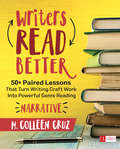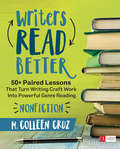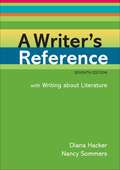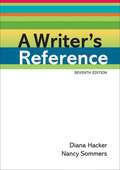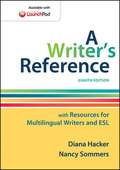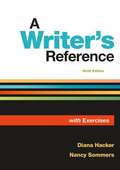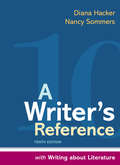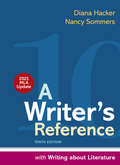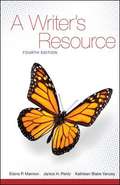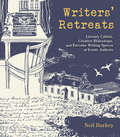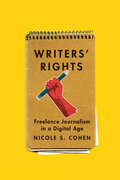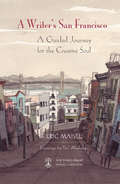- Table View
- List View
Writers Read Better: 50+ Paired Lessons That Turn Writing Craft Work Into Powerful Genre Reading (Corwin Literacy)
by M. Colleen CruzWhen It Comes to Reading, Writers Have an Advantage We know that writing skills reinforce reading skills, but what’s the best way to capitalize on this relationship? By flipping the traditional “reading lesson first, writing lesson second” sequence, Colleen Cruz helps you make the most of the writing-to-reading connection with 50 carefully matched lesson pairs centered around narrative texts. Lessons can be implemented either as a complete curriculum or as a supplement to an existing program. Complete with suggestions on adapting the lessons to suit the needs of your classroom and individual students, Writers Reader Better: Narrative offers a solid foundation for giving your students the advantage of transferable literacy skills.
Writers Read Better: 50+ Paired Lessons That Turn Writing Craft Work Into Powerful Genre Reading (Corwin Literacy)
by M. Colleen CruzWhen It Comes to Reading, Writers Have an Advantage We know that writing skills reinforce reading skills, but what’s the best way to capitalize on this relationship? By flipping the traditional “reading lesson first, writing lesson second” sequence, Colleen Cruz helps you make the most of the writing-to-reading connection with 50 carefully matched lesson pairs centered around narrative texts. Lessons can be implemented either as a complete curriculum or as a supplement to an existing program. Complete with suggestions on adapting the lessons to suit the needs of your classroom and individual students, Writers Reader Better: Narrative offers a solid foundation for giving your students the advantage of transferable literacy skills.
Writers Read Better: 50+ Paired Lessons That Turn Writing Craft Work Into Powerful Genre Reading (Corwin Literacy)
by M. Colleen CruzWe know that writing skills reinforce reading skills, but what’s the best way to capitalize on this beneficial relationship? By flipping the traditional "reading lesson first, writing lesson second" sequence, Colleen Cruz ingeniously helps you make the most of the writing-to-reading connection with carefully matched, conceptually connected lesson pairs. The result is a healthy reciprocity that effectively and efficiently develops students’ literacy skills. Backed by long-term academic and field research, Writers Read Better presents a series of 50 tightly interconnected lesson pairs that can be implemented either as supplement existing curriculum or as a stand alone module. Each pairing leads with a writing lesson, used as a springboard for the reading lesson that will follow. Throughout the book’s four sections, organized to cover distinct and complementary phases of working with non-fiction texts, you’ll discover Helpful insights on preparing for the section’s overarching goals Clear guidance on the intention of each lesson, what materials are required, and step-by-step plans for leading the activity Sample teacher language for leading the lesson Tips on building and organizing your classroom library, and how you can incorporate the tools, technology and media available in your classroom to make each lesson most effective Sample student work, online videos and other supporting resources Complete with practical suggestions on adapting the lessons to suit the particular needs of your classroom as well as individual students, Writers Reader Better offers a solid foundation for giving your students the advantage of powerful, transferable literacy skills.
Writers Read Better: 50+ Paired Lessons That Turn Writing Craft Work Into Powerful Genre Reading (Corwin Literacy)
by M. Colleen CruzWe know that writing skills reinforce reading skills, but what’s the best way to capitalize on this beneficial relationship? By flipping the traditional "reading lesson first, writing lesson second" sequence, Colleen Cruz ingeniously helps you make the most of the writing-to-reading connection with carefully matched, conceptually connected lesson pairs. The result is a healthy reciprocity that effectively and efficiently develops students’ literacy skills. Backed by long-term academic and field research, Writers Read Better presents a series of 50 tightly interconnected lesson pairs that can be implemented either as supplement existing curriculum or as a stand alone module. Each pairing leads with a writing lesson, used as a springboard for the reading lesson that will follow. Throughout the book’s four sections, organized to cover distinct and complementary phases of working with non-fiction texts, you’ll discover Helpful insights on preparing for the section’s overarching goals Clear guidance on the intention of each lesson, what materials are required, and step-by-step plans for leading the activity Sample teacher language for leading the lesson Tips on building and organizing your classroom library, and how you can incorporate the tools, technology and media available in your classroom to make each lesson most effective Sample student work, online videos and other supporting resources Complete with practical suggestions on adapting the lessons to suit the particular needs of your classroom as well as individual students, Writers Reader Better offers a solid foundation for giving your students the advantage of powerful, transferable literacy skills.
A Writer's Reference
by Diana Hacker Nancy SommersFor success in college, no skill is more critical than writing; it's the very core of a student's academic experience. Tested and trusted, A Writer's Reference is an essential tool for students who are strengthening habits and skills that will support them throughout college. In an April 2014 survey of first-year writers, 75 percent reported that using a Hacker handbook made them a more confident academic writer. What's more, A Writer's Reference has been a powerful tool for change across college campuses--helping to create a culture of writing at many schools by supporting a common language for talking about academic writing. In that way, A Writer's Reference is uniquely positioned to help transform attitudes about the value of writing instruction and the role that writing plays in academic work and in higher learning. With this eighth edition of the handbook, author Nancy Sommers invites you to be part of a community of those who teach and assign writing; who believe that critical reading, analytical writing, responsible research, and clarity are at the center of effective writing across the academy; and who use the nation's best-selling and most responsive handbook to support the development of the college writer.
A Writer’s Reference
by Diana Hacker Nancy SommersFor success in college, no skill is more critical than writing; it's the very core of a student's academic experience. Tested and trusted, A Writer's Reference is an essential tool for students who are strengthening habits and skills that will support them throughout college. In an April 2014 survey of first-year writers, 75 percent reported that using a Hacker handbook made them a more confident academic writer. What's more, A Writer's Reference has been a powerful tool for change across college campuses--helping to create a culture of writing at many schools by supporting a common language for talking about academic writing. In that way, A Writer's Reference is uniquely positioned to help transform attitudes about the value of writing instruction and the role that writing plays in academic work and in higher learning. With this eighth edition of the handbook, author Nancy Sommers invites you to be part of a community of those who teach and assign writing; who believe that critical reading, analytical writing, responsible research, and clarity are at the center of effective writing across the academy; and who use the nation's best-selling and most responsive handbook to support the development of the college writer. LaunchPadLaunchPad combines an interactive e-book with high-quality multimedia content and ready-made assessment options, including LearningCurve adaptive quizzing. Pre-built units are easy to assign or adapt with your own material, such as readings, videos, quizzes, discussion groups, and more. LaunchPad also provides access to a grade book that provides a clear window on performance for your whole class, for individual students, and for individual assignments. The result is superior book specific content in a breakthrough user interface in which power and simplicity go hand in hand. To package LaunchPad free with A Writer's Reference, Eighth Edition, use ISBN 978-1-319-00920-5.
A Writer's Reference: With Writing About Literature
by Diana Hacker Nancy SommersThis version of the best selling college handbook includes a tabbed section called Writing about Literature, a practical guide to interpreting works of literature and to planning, composing, and documenting papers about literature. Students will find help with forming and supporting an interpretation, avoiding plot summary, integrating quotations from a literary work, observing the conventions of literature papers, and using secondary sources. Writing about Literature also includes two sample student essays — one that uses primary sources and one that uses primary and secondary sources. The full primary texts are also included.
A Writer's Reference
by Diana Hacker Nancy SommersEngage more. Achieve more.A Writer’s Reference helps you engage in and meet the challenges of your writing course. Clear How-to boxes help you complete common writing assignments like argument and analysis. Guidance about paraphrasing and fact-checking sources help you become a more responsible writer and reader. And Notes-to-self help you reflect on your progress and plan your revision. If your instructor has assigned Achieve, you have new ways to engage with course material and with your instructor and peers. Revision planning tools and individualized study plans help you become a better writer, and a built-in e-book puts your problem and your solution side by side.
A Writer's Reference
by Diana Hacker Nancy SommersA Writer’s Reference answers common writing questions, helps you accomplish college assignments with confidence, and gives you strategies for using AI tools responsibly to save time but still sound like you.
A Writer's Reference
by Diana Hacker Nancy SommersA Writer's Reference, the most widely adopted handbook in the United States, continues to be groundbreaking in its simplicity, offering the right content in an accessible format. New coauthor Nancy Sommers's own research, campus travel, and classroom experience keep the handbook in tune with the needs of academic writers. In a trusted quick-reference format, the seventh edition delivers advice on all the right topics: working with sources, revising with comments, preparing a portfolio, and more. A Writer's Reference offers unprecedented flexibility with several versions to choose from -- a handbook that's truly at your service. Read the preface.
A Writer's Reference: with Resources for Multilingual Writers and ESL
by Diana Hacker Nancy Sommers Kimberli HusterThis version of the best-selling college handbook helps both resident and international students understand college expectations and develop strategies for improving their academic English and academic writing. Written by an ESL expert, this booklet includes plenty of helpful charts, activities, exercises, and model papers -- along with notes about where to find additional resources online and on campus.
A Writer's Reference
by Diana Hacker Nancy Sommers Tom Jehn Jane RosenzweigHaving helped nearly 3 million students at 1,600 colleges and universities to write well,A Writer's Referencesucceeds because it has always been grounded in classroom experience. Nearly twenty years ago, Diana Hacker reinvented the college handbook by looking at her own students' needs. She crafted a first-of-its-kind reference that offered practical solutions to college writing problems in a language students could understand and in a format that was easy for them to use. Her many innovations -- hand-edited sentences, grammar checker boxes, student-friendly index entries, ESL coverage, and a lay-flat comb binding -- have been widely imitated but never improved upon. In the Hacker tradition, the new contributing authors -- Nancy Sommers, Tom Jehn, Jane Rosenzweig, and Marcy Carbajal Van Horn -- have crafted solutions for the writing problems of today's college students. Together they give us a new edition that provides more help with academic writing and that works better for a wider range of multilingual students.
A Writer’s Reference (6th edition)
by Diana HackerA Writer's Reference is the most widely adopted college handbook ever published. The new edition is available in a classic version that provides more help with academic writing, serves a wider range of multilingual students, and lends more support for college research -- all in an easy-to-use quick-reference format. Now for all the ways you teach your course, you can choose the classic version or choose from among 4 additional versions with varied content. A Writer's Reference with Exercises is tailor-made for classroom use or for additional grammar practice with 86 integrated exercise sets. A Writer's Reference with Writing in the Disciplines provides help for college writing beyond composition with advice and models in six academic disciplines. A Writer's Reference with Writing about Literature includes an entire tabbed section on interpreting and writing about works of literature, with two annotated student essays. A Writer's Reference with Extra Help for ESL Writers includes an entire tabbed section for nonnative speakers of English; it offers targeted advice and strategies for college writing and research.
A Writer's Reference (6th Edition with 2009 MLA Update)
by Diana HackerRead this to find out more about the 2009 MLA updates and the 2010 APA updates. A Writer's Reference is the most widely adopted college handbook ever published. The new edition is available in a classic version that provides more help with academic writing, serves a wider range of multilingual students, and lends more support for college research -- all in an easy-to-use quick-reference format. Now for all the ways you teach your course, you can choose the classic version or choose from among 4 additional versions with varied content. A Writer's Reference with Exercises is tailor-made for classroom use or for additional grammar practice with 86 integrated exercise sets. A Writer's Reference with Writing in the Disciplines provides help for college writing beyond composition with advice and models in six academic disciplines. A Writer's Reference with Writing about Literature includes an entire tabbed section on interpreting and writing about works of literature, with two annotated student essays. A Writer's Reference with Extra Help for ESL Writers includes an entire tabbed section for nonnative speakers of English; it offers targeted advice and strategies for college writing and research.
A Writer's Reference With Exercises
by Diana Hacker Nancy SommersOur best selling classic tabbed handbook is available in a version that conveniently includes nearly one hundred integrated exercise sets for plenty of practice with the grammar, style, punctuation, and mechanics topics offered in the handbook. The answers to lettered items appear in the back of the book.
A Writer’s Reference with Writing about Literature
by Diana Hacker Nancy SommersWriting about Literature is a practical guide to interpreting works of literature and to planning, composing, and documenting papers about literature. Students will find help with forming and supporting an interpretation, avoiding plot summary, integrating quotations from a literary work, observing the conventions of literature papers, and using secondary sources. Writing about Literature also includes two sample student essays — one that uses only a primary source and one that uses primary and secondary sources.
A Writer’s Reference with Writing About Literature (Ninth Edition)
by Diana Hacker Nancy SommersA Hacker handbook has always been a how-to manual for building confidence as a college writer. Diana Hacker conceived A Writer's Reference as a quick-access innovation in handbook format, and Nancy Sommers continues to reinvent its content for an evolving course emphasizing critical reading and writing. For more than 25 years, the book has allowed students to build confidence and take ownership of their college writing experience. A Writer's Reference, Ninth Edition, and LaunchPad for A Writer's Reference together represent a next-level tool for college writers. What's most exciting? An emphasis on help that is personal, practical, and digital. A Writer's Reference is reimagined as a system that helps students target their needs and see their successes; that offers innovative practice with writing, reading, thinking, and research; and that lives in an engaging multimedia environment.
A Writer's Reference with Writing about Literature, with 2021 MLA Update: A Hacker Handbooks Supplement
by Diana Hacker Nancy SommersThis ebook has been updated to provide you with the latest guidance on documenting sources in MLA style and follows the guidelines set forth in the MLA Handbook, 9th edition (April 2021).Writer's Reference with Writing about Literature, is a practical guide to interpreting works of literature and to planning, composing, and documenting papers about literature. Students will find help with forming and supporting an interpretation, avoiding plot summary, integrating quotations from a literary work, observing the conventions of literature papers, and using secondary sources. Writer's Reference with Writing about Literature also includes two sample student essays — one that uses only a primary source and one that uses primary and secondary sources.
A Writer's Resource: A Handbook for Writing and Research (Fourth Edition)
by Elaine P. Maimon Janice H. Peritz Kathleen Blake YanceyA Writer's Resource focuses on the most common assignments and writing situations students will encounter in and beyond college, helping them to meet the challenges of composing in different genres and media.
Writers' Retreats: Literary Cabins, Creative Hideaways, and Favorite Writing Spaces of Iconic Authors
by Neil BurkeyFeaturing over 50 writers and their getaways--get a glimpse into the creative habits of some of the greatest writers of the last two centuries. From Henry David Thoreau's famous cabin at Walden Pond and James Baldwin's 'Welcome Table' in Provence, to Roald Dahl's garden hut and Toni Morrison's sunrise-lit couch at dawn, Writers' Retreats reveals the quirky, private, and sometimes curious places where literary magic has happened. Each location is brought to life through illustration and the writer's own words on what made that place so perfect for creating.An exploration of famous literary writers of past and present, from Emily Dickinson and Marcel Proust to Margaret Atwood, Chimamanda Ngozi Adichie, and Alice Munro, this is the perfect bookish gift for both writers and booklovers to feed their fascination with what ignited the creativity behind their favorite works of literature.
Writers' Rights: Freelance Journalism in a Digital Age
by Nicole S. CohenAs media industries undergo rapid change, the conditions of media work are shifting just as quickly, with an explosion in the number of journalists working as freelancers. Although commentary frequently lauds freelancers as ideal workers for the information age - adaptable, multi-skilled, and entrepreneurial - Nicole Cohen argues that freelance media work is increasingly precarious, marked by declining incomes, loss of control over one's work, intense workloads, long hours, and limited access to labour and social protections. Writers' Rights provides context for freelancers' struggles and identifies the points of contention between journalists and big business. Through interviews and a survey of freelancers, Cohen highlights the paradoxes of freelancing, which can be simultaneously precarious and satisfying, risky and rewarding. She documents the transformation of freelancing from a way for journalists to resist salaried labour in pursuit of autonomy into a strategy for media firms to intensify exploitation of freelance writers' labour power, and presents case studies of freelancers' efforts to collectively transform their conditions. A groundbreaking and timely intervention into debates about the future of journalism, organizing precariously employed workers, and the transformation of media work in a digital age, Writers' Rights makes clear what is at stake for journalism's democratic role when the costs and risks of its production are offloaded onto individuals.
Writers' Rights: Freelance Journalism in a Digital Age
by Nicole S. CohenAs media industries undergo rapid change, the conditions of media work are shifting just as quickly, with an explosion in the number of journalists working as freelancers. Although commentary frequently lauds freelancers as ideal workers for the information age – adaptable, multi-skilled, and entrepreneurial – Nicole Cohen argues that freelance media work is increasingly precarious, marked by declining incomes, loss of control over one’s work, intense workloads, long hours, and limited access to labour and social protections. Writers’ Rights provides context for freelancers’ struggles and identifies the points of contention between journalists and big business. Through interviews and a survey of freelancers, Cohen highlights the paradoxes of freelancing, which can be simultaneously precarious and satisfying, risky and rewarding. She documents the transformation of freelancing from a way for journalists to resist salaried labour in pursuit of autonomy into a strategy for media firms to intensify exploitation of freelance writers’ labour power, and presents case studies of freelancers’ efforts to collectively transform their conditions. A groundbreaking and timely intervention into debates about the future of journalism, organizing precariously employed workers, and the transformation of media work in a digital age, Writers’ Rights makes clear what is at stake for journalism’s democratic role when the costs and risks of its production are offloaded onto individuals.
A Writer's San Francisco
by Paul Madonna Eric MaiselWhy does San Francisco hold such a special place in the history of American art and literature, and in the hearts of creative people everywhere? Come discover its allure with author Eric Maisel, America's foremost creativity coach. He reveals the city's writerly haunts, local oddities, and hidden treasures, as well as practical tips for writers in any locale. In thirty-two essays, each accompanied by a charming full-color drawing by Paul Madonna, A Writer's San Francisco takes an enchanted journey through one of the world's great cities and the creative process itself. Walk San Francisco's twisting streets, climb its famous hills, explore bohemian landmarks like City Lights Bookstore, and check out lesser-known neighborhoods like Bernal Heights. Along the way, Maisel conjures San Francisco writers past and present, including Twain, Ferlinghetti, and Kerouac, and tells personal stories from his three decades as a Bay Area writer, teacher, and creativity coach. Among the many lessons he offers are what it takes to persevere as a creative soul, how to be both parent and artist, and how to spend a perfect writing day in earthquake country. Paul Madonna's lavish drawings further illuminate the ambiance and romance of the City by the Bay. Whether you're a resident San Franciscan, a visitor, an armchair traveler, or an artistic soul seeking inspiration, in these pages you'll find practical lessons to inspire you. This is an intimate journey through the legendary city and through the mysterious terrain where art blooms.
The Writer's Source Book: Inspirational ideas for your creative writing
by Chris SykesLEARN NEW AND INSPIRING WAYS OF LIFTING YOUR CREATIVE WRITING.Is your creative writing in need of inspiration? Do you need confidence to create watertight plots and believable characters?The Writer's Source Book provides dozens of practical exercises to help you create storylines, craft people and generate ideas, with support and creative insight for every stage.It will give you support in identifying your genre and crafting your work around it, and help you to understand the complexities of plot and character before beginning to create your own.Inspired and inspiring exercises will help you master the structure of your book, story or play, while focused and innovative advise will help those who have run into trouble. This is a technical manual ideal for any writer who needs to build, fix, polish or perfect their storyline.ABOUT THE SERIESThe Teach Yourself Creative Writing series helps aspiring authors tell their story. Covering a range of genres from science fiction and romantic novels, to illustrated children's books and comedy, this series is packed with advice, exercises and tips for unlocking creativity and improving your writing. And because we know how daunting the blank page can be, we set up the Just Write online community at tyjustwrite, for budding authors and successful writers to connect and share.
